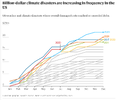- Joined
- 30 June 2008
- Posts
- 15,667
- Reactions
- 7,518
Yeah. Quite right. In fact it was the Re Insurance companies which first highlighted the reality and dangers of global warming.Insurance was all ways going to be the reality check when measuring risk
Yeah. Quite right. In fact it was the Re Insurance companies which first highlighted the reality and dangers of global warming.Insurance was all ways going to be the reality check when measuring risk
 Jason Alexandra
Jason Alexandra Kate Lawrence
Kate Lawrence Mark Howden
Mark Howden
 theconversation.com
theconversation.com
bias warning i hold QBE , SUN and TWRIts just possible there is another take on all this.
Namely it gives the insurance companies an excuse to raise premiums so they can make more money.
But surely i hear you say, insurance companies really care about the planet, and would not just be interested in increasing prfits!.
Of course not.
mick



The impact of extreme weather events turbo charged by global warming continues to undermine the Insurance industry. Check out the top 5 years of insurance costs in the table below
Hurricane Idalia could become 2023’s costliest climate disaster for the US
Analysts estimate the category 3 storm has already racked up a preliminary cost of $9.36bn, straining the insurance industry
Richard Luscombe in Miami
@richlusc
Thu 31 Aug 2023 22.37 AESTFirst published on Thu 31 Aug 2023 20.00 AEST
Hurricane Idalia could become the costliest climate disaster to hit the US this year, analysts say, with massive implications for the insurance and risk management industries.
The category 3 storm that barreled into Florida’s west coast from the Gulf of Mexico on Wednesday, then carved a path of destruction and flooding through Georgia and the Carolinas, has a preliminary price tag between $9.36bn, based on early estimates, from risk analysts at UBS, and $18bn-$20bn calculated by AccuWeather.
View attachment 161849
What is a storm surge and what is the threat from Hurricane Idalia?
Read more
It follows 15 previous “individual weather and climate disasters” recorded in the US already this year by the National Oceanic and Atmospheric Administration (Noaa) as unprecedented heat, wildfires, storms and floods escalate.
Cumulatively, Noaa said that by the end of July, which Nasa said was Earth’s hottest month on record, the total estimated cost of the damage caused by the disasters was $39.7bn. That figure does not include the estimated $5.5bn cost to rebuild the town of Lahaina following devastating wildfires that razed the Hawaiian island of Maui this month.
“The costs are becoming unbearable,” said Tom Larsen, senior director of insurance solutions at CoreLogic, a property analytics provider that publishes an annual hurricane risk report.
“The business of insuring for catastrophes used to mean exceptional, very rare events and that’s not what we’re seeing. These are much more common, so something’s got to change.”
Larsen noted that Hurricane Idalia’s strike in a rural and lesser-populated area of Florida, with fewer insured structures, would keep its eventual cost below other major cyclones, such as Hurricane Ian that struck last year and left a $113bn trail of devastation.
But he is concerned about the possible impact on an already fragile insurance market in Florida, which has seen several large providers leave or go out of business in the last two years despite efforts by state lawmakers to make it a more welcoming environment.
Fewer providers means higher premiums to consumers, and the cost of reinsurance, which insurance companies purchase to limit their own exposure, has soared. That cost is also passed on to customers, further fueling the home insurance crisis.

Hurricane Idalia could become 2023’s costliest climate disaster for the US
Analysts estimate the category 3 storm has already racked up a preliminary cost of $9.36bn, straining the insurance industrywww.theguardian.com
View attachment 161848
Common sense says that changing the composition of the atmosphere ought have some effect on something. Change one variable and it's going to upset something somehow.in some ways it's a legitimate issue which we should be addressing

but will it be enough to give me another cheap entry into QBE ?The impact of extreme weather events turbo charged by global warming continues to undermine the Insurance industry. Check out the top 5 years of insurance costs in the table below
Hurricane Idalia could become 2023’s costliest climate disaster for the US
Analysts estimate the category 3 storm has already racked up a preliminary cost of $9.36bn, straining the insurance industry
Richard Luscombe in Miami
@richlusc
Thu 31 Aug 2023 22.37 AESTFirst published on Thu 31 Aug 2023 20.00 AEST
Hurricane Idalia could become the costliest climate disaster to hit the US this year, analysts say, with massive implications for the insurance and risk management industries.
The category 3 storm that barreled into Florida’s west coast from the Gulf of Mexico on Wednesday, then carved a path of destruction and flooding through Georgia and the Carolinas, has a preliminary price tag between $9.36bn, based on early estimates, from risk analysts at UBS, and $18bn-$20bn calculated by AccuWeather.
View attachment 161849
What is a storm surge and what is the threat from Hurricane Idalia?
Read more
It follows 15 previous “individual weather and climate disasters” recorded in the US already this year by the National Oceanic and Atmospheric Administration (Noaa) as unprecedented heat, wildfires, storms and floods escalate.
Cumulatively, Noaa said that by the end of July, which Nasa said was Earth’s hottest month on record, the total estimated cost of the damage caused by the disasters was $39.7bn. That figure does not include the estimated $5.5bn cost to rebuild the town of Lahaina following devastating wildfires that razed the Hawaiian island of Maui this month.
“The costs are becoming unbearable,” said Tom Larsen, senior director of insurance solutions at CoreLogic, a property analytics provider that publishes an annual hurricane risk report.
“The business of insuring for catastrophes used to mean exceptional, very rare events and that’s not what we’re seeing. These are much more common, so something’s got to change.”
Larsen noted that Hurricane Idalia’s strike in a rural and lesser-populated area of Florida, with fewer insured structures, would keep its eventual cost below other major cyclones, such as Hurricane Ian that struck last year and left a $113bn trail of devastation.
But he is concerned about the possible impact on an already fragile insurance market in Florida, which has seen several large providers leave or go out of business in the last two years despite efforts by state lawmakers to make it a more welcoming environment.
Fewer providers means higher premiums to consumers, and the cost of reinsurance, which insurance companies purchase to limit their own exposure, has soared. That cost is also passed on to customers, further fueling the home insurance crisis.

Hurricane Idalia could become 2023’s costliest climate disaster for the US
Analysts estimate the category 3 storm has already racked up a preliminary cost of $9.36bn, straining the insurance industrywww.theguardian.com
View attachment 161848
but geological experience also proves that C02 concentration does not significantly affect the world temperature.(at least not a 2 or 4 or 10% increaseCommon sense says that changing the composition of the atmosphere ought have some effect on something. Change one variable and it's going to upset something somehow.
Scientific knowledge gives us a pretty good idea what those effects are likely to be. Not a perfect understanding, but it points us in the overall right direction that temperature would be expected to change.
But yes, there's a lot of nonsense surrounding it all. A lot of things that are basically along the lines of saying that we stopped burning off, then because we've stopped burning off someone decided to build houses deep in the bush, then there was a fire disaster. Now since we didn't have such disasters previously it must be climate change.
There's real science here but there's also politics and there's also the consequences of stupidity. The key is to separate which is which.
Climate has, after all, become a catch-all get out of jail card for failures of firefighting, water supply, power supply, road maintenance, flood prevention and so on. If anything goes wrong then just blame climate. Never mind that the firefighting budget was cut in half whilst nobody bothered to maintain the power line through the overgrown bush the combination of which unsurprisingly ended in disaster.

And this from KPMGAcross both types of insurance – life insurance and general insurance, which includes everything from pets to cars and homes – total profit has quadrupled, ballooning from $1.4bn in the 2022 financial year to $5.8bn in the 2023 financial year.29 Aug 2023
The insurance companies are laying the groundwork to increase premiums and thus their profit margins.Gross Written Premium (GWP)
- In the year to 30 June 2023, Gross Written Premium (GWP) for general insurers1 has increased by 12.2%. There have been increases in GWP across all major lines of business, except for Professional Indemnity, primarily driven by increases in average premiums.
- Average premiums for the year to 30 June 2023 have increased by 10-18% for property classes including Domestic and Commercial Motor, Houseowners and Householders’ insurance, and Fire and ISR. Over the same period, average premiums for Public and Product liability have increased by 14.5%, whilst average premiums for CTP and Professional Indemnity have remained relatively flat.
- For the year to 30 June 2023, Commercial Motor and CTP have seen growth of 5.5% and 5.6% respectively in the number of risks written.
- Other lines of business include the Travel insurance product, which has seen a return of gross written premiums to pre-COVID levels. This is attributed to increased travel over this period, and a greater cost for travel insurance than prior to COVID-19.
Underwriting Profitability
- In the year to 30 June 2023, Underwriting Profitability for general insurers1 was $5.70 billion, compared to the underwriting result of $6.08 billion in the previous 12 months.
- The main drivers behind Underwriting Profitability movements from the 2022 financial year to the 2023 financial year are:
- Fire and ISR, which includes commercial property, has had an increase in underwriting result from $911 million in the 2022 financial year to $2,051 million in the 2023 financial year. This increase in underwriting profit has primarily been due the release of reserves for Business Interruption by insurers following recent court decisions on policy wordings for pandemic exclusions and also as a result of premium increases.
- Severe weather-related events have impacted the results of both the 2022 and 2023 years. These events include the May 2023 Newcastle hailstorm, Central West NSW floods in November 2022; Victoria, NSW and Tasmania floods in October 2022; NSW floods in July 2022; and Queensland and NSW floods from February to April 2022.
- Increases in net incurred claims for the March 2023 quarter to $9.17 billion, which had increased by 20.4% compared to the December 2022 quarter ($7.62 billion) and increased by 36.5% compared to the March 2022 quarter ($6.72 billion).
but other scenarios , like widespread civil unrest , or a wave of business collapses , could easily make those cash reserves look inadequateThe real story.
Always follow the money. Always.
From Daily telegraph
And this from KPMG
The insurance companies are laying the groundwork to increase premiums and thus their profit margins.
They know full well that there is little Australians, either at a personal level or at Government level can do to mitigate climate change.
If we eliminate all fossil fuel usage from OZ, it will make such a small impat it will not be noticable to anyone.
The Insurance companies need to talk to the Chinese, the Americans, the Indians, the members of OPEC etc etc.
Mick

yes the planet will survive climate change, but that doesn’t mean our civilisation as we have built it will, or that it will be an enjoyable process.the only sound logic for zero-carbon emissions is if you planned to totally deforest the Earth , which is possible given the rapacious predators driving this agenda , because nature is rather capable of adapting planetary life all by itself without the help of these egotistical half-wits .
( several million years of history/archaeology proves that , or science is a cess-pit of lies )
When it comes to insurance companies, they aren‘t really as concerned about increasing “Profit Margins” as they are with avoiding losses, and the best way to reduce your chance of losses in insurance is to price your premiums right.The real story.
Always follow the money. Always.
From Daily telegraph
And this from KPMG
The insurance companies are laying the groundwork to increase premiums and thus their profit margins.
They know full well that there is little Australians, either at a personal level or at Government level can do to mitigate climate change.
If we eliminate all fossil fuel usage from OZ, it will make such a small impat it will not be noticable to anyone.
The Insurance companies need to talk to the Chinese, the Americans, the Indians, the members of OPEC etc etc.
Mick
Hello and welcome to Aussie Stock Forums!
To gain full access you must register. Registration is free and takes only a few seconds to complete.
Already a member? Log in here.